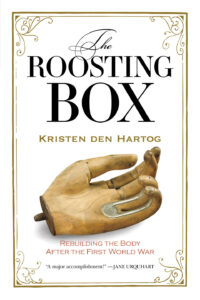February 21, 2024
The Roosting Box: Rebuilding the Body After the First World War, by Kristen den Hartog
Whoever you are, I can likely promise you that The Roosting Box, by Kirsten den Hartog, is not like any book you’ve read before. den Hartog is an award-winning novelist, co-author of two other books of historical nonfiction, and her approach to history in this latest offering is lyrical (lines in italics throughout the book which are embedded in her own prose are actually borrowed from poets who died in World War One, figures she sees as ghosts who haunt the text), whimsical (“In a way it was a magical time,” the book begins, “given that magic can be dark or bright or both at once. Men by the thousands travelled up into the clouds in flying machines. Submarines lurked below the surface of the water and the men inside fired torpedoes at the enemy just like toys come to life. Little figurines full of wishes and nightmares.”) with the most prosaic setting possible (a former cash register factory beside the railway tracks, not far from the tannery with a view from the roof of the Ford Motor Company) that turns out to be the springboard for so many true stories, some heartening, most harrowing, making clear the enormity and inhumanity of what people and other creatures are forced to survive (and/or perish by) in war.
But then den Hartog has a better metaphor (this is why she wrote this book, and I didn’t)—not a springboard, but a roosting box, “a communal space that provides ideal but temporary shelter for [the] vulnerable.” That space is the National Cash Register Factory in Toronto, which by 1918 was converted into the Dominion Orthopaedic Hospital, and would become the Christie Street Veterans Hospital. The book is not a history of the hospital itself per se (though it’s loosely structured around its opening and ends with its replacement by Sunnybrook Hospital in the 1940s, as a new generation of wounded soldiers came home from another war), but instead a collection of stories about the lives of people who graced its halls, patients, doctors, nurses, and more—dietitians and occupational therapists (both new professions for women that emerged at this time), artists and sculptors involved in facial reconstruction, no less than Frederick Banting, whose studies were tested on diabetic patients at Christie Street. “So while the hospital is at the centre of this book, the story travels off from that point in many directions—to battlefields, to small hometowns in Canada and abroad, into makeshift hospitals on the frontlines, and across the ocean on warships. It moves backward and forward in time, always returning to the place (and the concept) of healing.”
War does the most horrifying things to people’s minds and people’s bodies, which den Hartog makes clear in all these stories. She writes about field hospitals and medical boats coming under attack—justifications that the former was build too close to strategic targets and that the latter’s conspicuous red cross was a trick. The images are indelible of nurses’ bodies resurfacing in the water long after, their long blue dresses, and huge white veils. Did you know what being buried alive, even temporarily, does to a person’s digestive tract, let alone their psyche? She writes about the 1918 Influenza Pandemic sweeping the world, aided by the wartime necessity of people in such tight quarters, and how it took down the vulnerable patients at the Christie Street Hospital. Including Indigenous patients, many of whom served as essential snipers at the war front, but would come home again to be denied veteran’s benefits. Patients left mentally shattered by war were also scarcely supported after the fact, it being supposed that anything otherwise would be coddling. The week before the Christie Street Hospital opened, Toronto’s artificial limb workers went on strike, demanding that the industry be helmed by a returned soldier instead of a government bureaucrat. There was an artificial limb industry? I’d had no idea—I was born 60 years after armistice and until reading The Roosting Box, I’d never properly understood how huge the wounded population would have been at the time. I knew that the War Amps nonprofit was a thing, but I’d never thought about why. (Also, the prosthetics weren’t great. Even now, prosthetics can be painful, cumbersome and very expensive, but a century ago, it was sometimes easier to go without.)
A warning: once you pick up this book, you will likely annoy everyone around you by spouting fascinating facts out of context, like a bothersome robot, but pick it up anyway. In The Roosting Box, Kristen den Hartog has brought a piece of Toronto’s history to life, and the effect is pretty dazzling.







This sounds just wonderful.Thanks for showcasing it, Kerry!
I just finished reading this excellent book, and I can agree it’s unlike anything else I’ve read. It’s hard to capture in a review or summary the many layers den Hartog has unearthed of the stories of these people, seemingly brought to life again in her ‘beautifully written’ work. Even Jane Urquhart, famed author of The Stone Carvers, also about Canadians during the war, admits ‘my knowledge of my country and myself was changed’ by this book.